What is Fruit Fly?
Fruit fly is the most destructive pest infests only on Zizyphus species. It contributes towards low yield and poor quality of fruits and up to 80% loss under severe infestation (Batra, 1953).
Scientific Name – Carpomyia vesuviana Costa
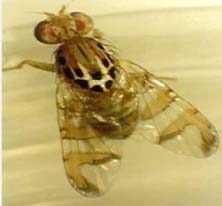
Life Cycle-
Egg: Female flies insert eggs under the skin of fruit in clusters of 10 to 50 about 1/25 to
1/8 inch below the fruit surface. The eggs measure about 1/25 by 1/250 inch and are
white, elongate, and elliptical. They hatch in 1-1/2 days.
Larva: The white larva is legless and resembles an elongated cone. The mouth is at
the pointed end of the body. There are 3 larval stages, or instars. The third instar is
about 2/5 inch long. The entire larval stage lasts for 11-15 days.
Pupa: When mature, larvae drop to the ground and pupate in the soil. The puparium is
yellowish-brown and seed-like. Adults emerge in about 10 days.
Adult: Generally, the abdomen has two horizontal black stripes and a longitudinal median stripe extending from the base of the third segment to the apex of the abdomen. These markings may form a “T” shaped pattern. Females begin to lay eggs about 8 days after emergence from the puparium. Under optimum conditions, a female can lay more than 3,000 eggs during her lifetime, but under field conditions approximately 1,200 to 1,500 eggs per female is considered to be the usual production.
How does Fruit Fly damage?
- Infestation starts with the onset of fruit setting.
- The excreta of the larva accumulate in the galleries, which may sometimes result in rotting of the fruit.
Infested fruits become deformed, and their growth becomes checked. A large number of such fruits drop off.

How to manage Fruit Fly-
| Cultural Practices | Mechanical Control |
| Clean cultivation/sanitation of orchards by picking and destroying the infested fruits should be done.Destroy the hibernating pupae by exposing them to bright sunlight and birds.Prior to harvest, collect and dispose off infested and fallen fruits to prevent further, multiplication and carry-over of population.If infestation is heavy, bait splash on the trunk only, once or twice at weekly interval is recommended. To prepare bait splash, mix 100 g of jaggery in one litre of water and add 1 ml of deltamethrin by using an old broom. | Installation of Pheromone trap @3-5/acre. |
| Biological Control | |
| The extract of azadiractin 1% and Ocimum sanctum 1% were effective up to 10 days after spraying. Application of neem powder and tobacco leaf extracts would also significantly reduce C. vesuviana damage and they could be the potential candidates for organic cultivation of ber. | |
Pheromone Trap –
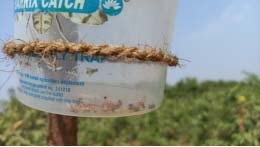 | 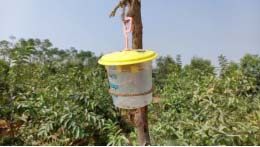 |
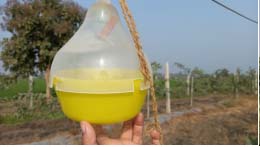 | 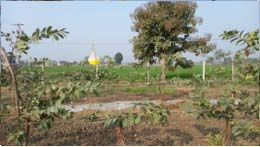 |
References: –
- https://ppqs.gov.in/sites/default/files/ber.pdf
- https://krishi.icar.gov.in/jspui/bitstream/123456789/5658/1/Ber%20Pest%20Tech%20Bulletin.pdf
- https://vikaspedia.in/agriculture/crop-production/integrated-pest-managment/ipm-for-fruit-crops/ipm-strategies-for-ber/ber-insect-and-mite-pests








